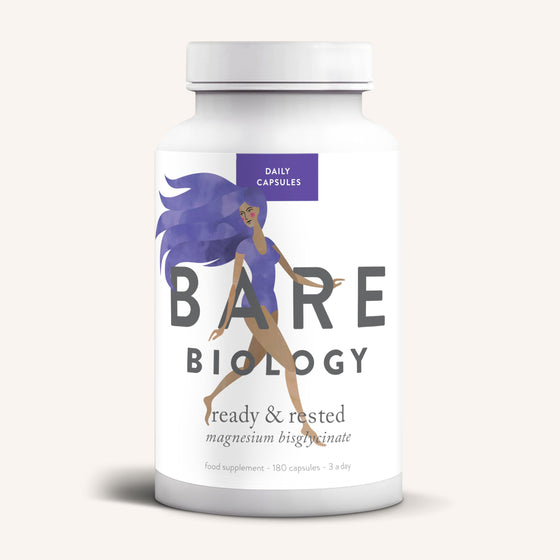Written by Nutritional Therapist Kate Fisk DipCNM, mBANT, mANP, rCNHC
For our body to work efficiently, its core temperature must remain within a very narrow range, close to 37C. As a result, our bodies are well-adapted to picking up small changes in the temperature and responding accordingly. Too hot, and we start to sweat, and our blood vessels dilate, encouraging blood flow to the surface of our skin, allowing it to cool quicker. Too cold, and the blood flow to our skin is restricted to limit heat loss. We also start to shiver and get goosebumps, which generates heat and makes our body hair stand on end, trapping warm air closer to our skin.
Generally speaking, women are more likely to be more sensitive to cold than men, as they have a lower resting metabolic rate, which means they burn fewer calories while at rest.
But if you find yourself always reaching for a jumper when everyone else is comfortable in a t-shirt, it could be down to an underlying issue.
1. Anaemia
There are many types of anaemia. The most common kind is iron deficiency anaemia. In short, anaemia either refers to a person having fewer red blood cells than average or it indicates a person's red blood cells can't carry enough haemoglobin.
As well as making us feel cold, other symptoms of anaemia include tiredness, shortness of breath, pale skin and an irregular heartbeat.
Anaemia can be caused by heavy periods, poor diet (particularly a lack of iron), or an increased need for iron, such as during pregnancy and childhood growth.
2. Underactive thyroid
Our thyroid is a butterfly-shaped gland sitting at the base of the neck. The hormones produced by the thyroid help regulate all sorts of things, including our heartbeat, blood pressure, brain development, menstrual cycle and body temperature.
If our thyroid is struggling to create enough hormones, or the hormones it does produce are not being converted efficiently, our metabolism slows, making us feel cold.
Other symptoms of an underactive thyroid include fatigue, dry skin, constipation, thinning hair, brittle nails, weight gain and low mood.
Factors that might contribute to an underactive thyroid include a poor diet, persistent stress, imbalances in gut bacteria and toxin exposure.
3. Lack of sleep
Our circadian rhythms, the internal clocks that contribute to keeping our hormones on an even keel, are partly responsible for regulating our body temperature. Governed by our exposure to light, they keep us cooler at night and warmer during the day. If we aren't getting enough sleep, our circadian rhythms will be out of whack, meaning the release of hormones that control our body temperature will be too.
4. Anxiety
When we feel anxious, our adrenalin kicks in, causing our heart rate to increase, and we breathe less deeply. Our body takes this as an indication of imminent danger, and our available energy reroutes to get us out of harm's way as quickly as possible. As a result, non-essential jobs such as digestion and reproduction get shunted down the priority list. Instead, blood flow is prioritised to our heart and muscles, enabling us to make a hasty escape, causing our extremities to become cold.
5. Low body weight
Being underweight will likely result in a lack of muscle or fat. Body fat insulates our internal organs and helps to keep us warm. When our muscles contract, they produce heat, so the less muscle we have, the less heat is generated.
As we age, we often lose muscle mass, which is one reason why older people feel the cold more.
We might find we feel the cold more if we're intentionally losing weight. This is because when we eat, our body uses energy to break down food and absorb and store any nutrients it contains. A by-product of this process is heat. It makes sense that if we're eating less, we have less fuel on the fire to keep us warm.
6. Diabetes
People with diabetes seem to have a more challenging time than others when it comes to controlling their body temperature. This could be because blood vessels in those with diabetes are less responsive and unable to regulate their temperature.
Insulin resistance, or a lack of insulin, is at the root of diabetes. Research suggests insulin plays a role in regulating body temperature, so a disruption in insulin signalling can mean the body can't maintain its core temperature.
As well as that, if left untreated, diabetes can cause nerve damage in the extremities, resulting in a reduced ability to detect temperature changes, making hands and feet feel cold. This is usually associated with other symptoms such as cramps, pain and loss of balance.
Other symptoms of diabetes include needing to pee more often, feeling thirsty all the time (even if drinking lots of water) and fatigue.
7. Dehydration
If we don't drink enough fluids, our blood vessels will become narrower to retain fluid levels. This restriction in the flow of blood can leave us feeling cold.
Other symptoms of dehydration include dark yellow pee, headaches and muscle cramps.
If properly hydrated, your pee should be a pale straw-like colour.
8. Poor circulation
If we've got poor circulation, it can be hard to keep our hands and feet warm as they're furthest from the heart, which keeps our blood flowing around the body, carrying oxygen, nutrients and waste products.
The most common contributing factors to poor circulation are obesity, high blood pressure, heart conditions and diabetes.
Other symptoms of poor circulation include tingling, pins and needles, cramps, fatigue, swelling in the feet and ankles, difficulty concentrating and numbness.
9. Raynaud's syndrome
Raynaud's is a condition most common in women in their 40s and 50s. It usually occurs in the hands and feet but can also affect the nose and lips. These areas become temporarily over-sensitive to cold as the blood vessels narrow much more than usual. Stress can also trigger Raynaud's. During an attack, the tips of the fingers and toes may turn white and then blue. This discolouration is accompanied by numbness and feeling extremely cold.
It's not known what causes Raynaud's, but it's often associated with autoimmune conditions such as rheumatoid arthritis.
10. Hormonal imbalance
If you're heading towards menopause or just about to get your period, fluctuating levels of sex hormones put you at a greater risk of being more sensitive to the cold. For example, progesterone tends to prompt an increase in temperature, whereas oestrogen does the opposite. It's suggested these fluctuations might occur throughout the menstrual cycle to support the best chance of a successful pregnancy.
What can I do to stop feeling cold all the time?
If you think you may be struggling with any of these conditions, book an appointment to discuss your concerns with your GP or other health practitioner.
In the meantime, here are a few tips that might help you keep warm:
- If you know quality sleep is missing from your life, make some changes to improve it. Aim for 7-8 hours a night and stick to a routine. To promote restful sleep, avoid caffeine after lunch, banish all screens from the bedroom, and ensure your bedroom is dark and not too warm or stuffy.
- Keep hydrated – having a glass of water first thing in the morning is a great way to start the day. Aim to drink about 1.5 litres every day.
- Keep moving! Regular exercise and breaks from sitting at your desk will support healthy circulation and help build muscle, both important for regulating your temperature.
- Gingerol, a compound found in ginger, elevates body temperature . Use it when cooking soups and curries. Or use fresh ginger to make some warming ginger tea.
- Make sure you're eating some quality protein with every meal. Examples include grass-fed meat, organic poultry and eggs, wild-caught fish, beans and pulses. Protein has a high thermic effect, meaning our body has to work harder to break it down than other foods, producing more heat as a by-product.
- Complex carbohydrates found in whole plant foods such as quinoa, brown rice and vegetables have a higher thermic effect than simple carbohydrates such as sugar and white flour in processed foods. This is because they take much longer to digest and so produce more heat.
- And lastly, build up your resilience to the cold by improving your brown fat reserves:
Most of our body fat is white fat which stores lots of energy and provides some insulation and padding for our internal organs. Too much, though, can increase the risk of health issues such as heart disease and type 2 diabetes.
Babies have bigger reserves of brown fat, as they can't shiver. But as we age, the amount of brown fat we have goes down. Most adults retain some around the shoulders, neck and spinal cord. Receptors in brown fat recognise when our body temperature is going down and start producing energy which converts into heat to keep us warm.
The best way to increase brown fat reserves? Increase your exposure to cold temperatures. One of the easiest ways to do this, unless you're up for a daily ice bath, is to turn your shower to cold for a minute just before you get out.





